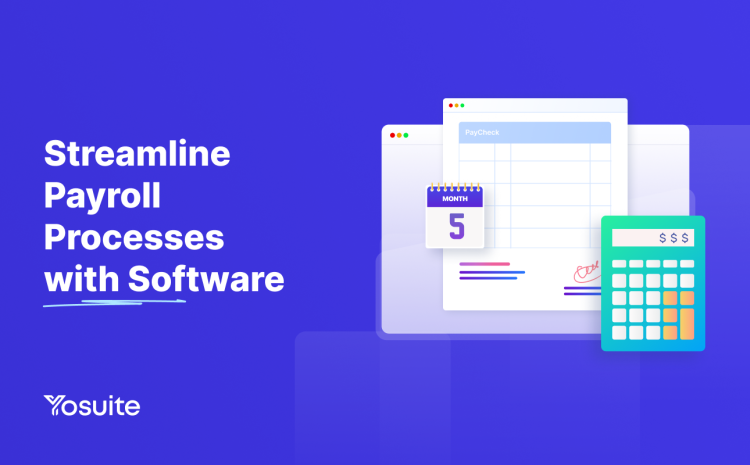In today’s fast-paced corporate world, payroll accuracy and efficiency are crucial. The manual process of the payroll system has long been the norm. Yet, they tend to be time-consuming, error-prone, and inefficient. With advanced online payroll software, organizations can streamline processes and enjoy many benefits.
Let’s get started with our journey of how to streamline payroll processes with software.
Table of Contents
Understanding the Challenges of Manual Payroll Processing

Before we talk about software-based streamlining, let’s first address the difficulties of manual payroll processing operations. These challenges include:
❎ Proneness to Errors
Manual calculation of employee wages, taxes, and deductions can result in frequent errors. It leads to discrepancies in pay and employee dissatisfaction.
❎ Time-Consuming and Labor-Intensive
Manual payroll processing demands significant time and effort from HR and finance teams. It involves repetitive tasks that could be better utilized for more strategic activities.
❎ Limited Scalability
As businesses grow, they must improve the manual process of payroll systems to handle the expanding workforce. This can cause delays and inefficiencies in the entire payroll process.
❎ Compliance Risks
Managing evolving payroll regulations and tax laws can be complex using manual systems. It increases the risk of non-compliance.
❎ Lack of Real-Time Insights
Manual processes need real-time reporting and analytics. It deprives businesses of valuable data insights for decision-making.
❎ Security Risks
To meet workers’ high expectations, safeguarding sensitive data is crucial. Manual payroll processing raises the risk of information being in the wrong hands.
❎ Document Handling and Organization
Managing employee documentation can cause issues with lost paperwork. It causes chaos in payroll distribution and affects the organization. Manual document storage can also lead to document loss.
❎ Hiring Overhead
Manual payroll distribution requires hiring more personnel. It can cause financial issues and increased spending due to insufficient individual completion.
The Power of Payroll Software (Benefits)

Payroll software is a major changer for business. It offers many benefits that can significantly improve the payroll management process. Here are some of the critical advantages of using payroll software:
✔️ Enhanced Accuracy and Reduced Errors
Manual payroll processing is susceptible to human errors. It can have serious financial and legal ramifications. Payroll software automates calculations. It results in minimized mistakes and ensures accurate and error-free payrolls.
✔️ Time Efficiency and Productivity
With payroll software, you can say goodbye to laborious manual calculations and paperwork. The automated system speeds up the entire process. It frees up valuable time for your HR and finance teams to focus on more strategic tasks. It boosts overall productivity.
✔️ Compliance and Legal Adherence
Staying compliant with ever-changing payroll regulations and tax laws can be daunting. Payroll software ensures it stays updated with the latest legal requirements. It reduces the risk of compliance-related issues and penalties.
✔️ Data Security and Confidentiality
Payroll data contains sensitive and confidential employee information. Payroll software offers robust security measures. Businesses can ensure that their critical data remains protected from unauthorized access.
✔️ Employee Satisfaction and Trust
Timely and accurate payrolls boost employee satisfaction and build trust in the workforce. Payroll software ensures accurate and timely payment for employees. It leads to higher employee morale and engagement.
Steps in Streamlining Payroll Processes with Software
Implementing payroll software is a transformative process that requires careful planning and execution. Let’s walk you through the essential steps on how to streamline payroll processes with software:
1. Assess Your Payroll Needs
Before selecting a payroll software solution, assess your organization’s specific payroll requirements. Consider the following factors before choosing the payroll software:
💡Company size and employee number.
💡Salary and paycheck model of the company.
💡Payment policy of the company.
💡Type of reporting required.
💡Allocated budget for payroll management.
2. Choose the Right Payroll Software
When selecting suitable payroll software, seek the following features:
✅ Payroll Processing and Management
The most vital aspects of Payroll software are processing and management. These ensure each employee receives accurate compensation through their preferred payment method. It forms the foundation for other supplementary payroll features.
✅ Employee Information Management
The Employee Information System is a comprehensive tool for managing all employee information in one place. It encompasses personal and professional details, employment contracts, onboarding paperwork, and more.
✅ Time and Attendance Tracking
Integrated time and attendance tracking calculates staff payroll based on actual hours worked. It ensures compliance by tracking and compensating employees for their contracted hours. Additionally, it calculates overtime at agreed rates as per the schedule or contract.
✅ Tax Calculation and Filing
Accurate tax filing is paramount for all businesses to avoid tax deposit challenges. The most dependable payroll system incorporates tax filing capabilities. Entrusting this complex task to software ensures precise tax calculations. It prevents issues with federal, state, local, social security, and other payroll taxes.
✅ Benefit and Deduction Management
The Benefit and Deduction Management feature deals with deductions and non-traditional payment methods. These adjustments include worker benefits, bonuses, overtime, and vacation pay. Payroll software can manage this without disrupting the processes already in place.
✅ Self-Service Portals
Self-Service Portals provide convenient access to employees’ essential information. This feature enables employees to access their pay stubs and payroll data. It eliminates the need to request such information from the HR department. With this functionality, employees can retrieve necessary payroll data and forms whenever.
✅ Reporting and Analytics
Including reporting and analytics features is essential for payroll systems. Payroll software provides valuable insights into your payroll processes. It offers a high-level overview of the business budget, taxes, and other payroll data. Utilizing this feature leads to cost savings and improved efficiency in the process.
✅ Compliance and Legal Requirements
Compliance is a crucial aspect of a smoother experience in managing financial matters. Adhering to regulations and maintaining accurate records ensures legal compliance. This proactive approach prevents legal action and potential fees from non-compliance.
✅ Integration with Other Systems
HR and payroll activities are interconnected, making managing them with separate systems impractical. Doing so only leads to increased workload and higher chances of errors. Opt for payroll software that integrates both payroll and HR processes.
✅ Security and Data Protection
Database encryption stands as the most vital security feature in payroll software. It safeguards valued resources like tax files, employee personal details, and payroll information. The security features also focus on controlled access and comprehensive audit trails.
✅ Mobile Accessibility
Payroll software should offer mobile accessibility, enabling employees to clock in and out using mobile time cards.
Once you understand your needs, research and compare different payroll software options available.
I know the selection process can be tough. But here are some types of payroll software available on the market that you can consider meeting your specific needs:
💡Internally Managed Payroll
💡Professionally Managed Payroll (Bookkeepers and CPAs)
💡Agency Managed Payroll (Payroll Service)
💡Software Managed Payroll (Online Payroll)
3. Prepare the Team for the Transition
The success of the transition heavily relies on the effectiveness of the training provided to your employees. Design a training program that caters to the specific needs of both the HR and finance teams. It is essential to address their unique roles and responsibilities in the payroll process. This tailored approach will help them gain a thorough understanding of the new software’s functionalities and how it aligns with their respective tasks.
4. Data Migration and System Set Up
Data migration to the new payroll software is critical. Ensure a smooth transfer by planning, testing, and validating the data carefully. Cleanse and organize your information to avoid duplicates and errors. Test the migration process in a controlled environment to address any issues proactively.
During migration, exercise caution and verify the data for accuracy. Assign a dedicated team to oversee the process and handle inquiries. Then, validate the data thoroughly and address discrepancies promptly to avoid payroll errors.
5. Integration with HR and Accounting Systems
Integrate payroll software with other systems for seamless management. This integration streamlines data flow. HR and accounting teams can access a comprehensive overview of employee-related financial data.
This unified approach enhances strategic planning and decision-making. Key stakeholders can analyze trends and patterns across both HR and financial data. This will enable your organization to optimize budgeting, forecasting, and resource allocation. Furthermore, this integration promotes better communication and collaboration between departments.
6. Employee Self-Service Portal Implementation
Empower your employees by offering them a self-service portal through the payroll software. This portal allows employees to access their pay stubs, update personal information, and view tax forms. It reduces the HR department’s administrative burden.
7. Track and Analyze Payroll Performance
Use payroll software’s reporting and analytics for tracking performance. Analyzing data insights can help identify trends, highlight inefficiencies, and make informed decisions. Tracking payroll software performance helps identify process challenges.
8. Regular Software Updates and Training
Payroll software is evolving to meet new requirements and technological advancements. Ensure you stay updated with the latest software versions and train your team regularly to optimize its usage.
FAQs
Is payroll software suitable for small businesses?
Yes, it is beneficial for small size businesses. It can significantly reduce manual efforts, enhance accuracy, and streamline payroll processes. It is an excellent choice for all-level enterprises.
Can payroll software handle complex payroll calculations?
Absolutely! Payroll software can handle intricate payroll calculations, including taxes, deductions, bonuses, and more. Its automation ensures accurate results, even in complex scenarios.
How secure is payroll software?
Top-tier payroll software solutions have robust security measures to protect sensitive employee data. Look for software that offers encryption, secure login protocols, and regular data backups.
What are the cost implications of implementing payroll software?
The payroll software costs vary based on the features, scalability, and vendor. While there might be an initial investment, the long-term benefits of efficiency and accuracy outweigh the costs
Final Words
Embracing payroll software can be a transformative decision for any organization. How do you streamline payroll processes? Integrate payroll software and put the outlined processes into great consideration.
Undeniably, payroll software allows you to:
💡 Save time,
💡 Reduce errors,
💡 Ensure compliance, and
💡 Boost satisfaction.
The power of payroll software lies in its ability to drive efficiency and productivity, enabling organizations to focus on growth and success.



Leave a Reply